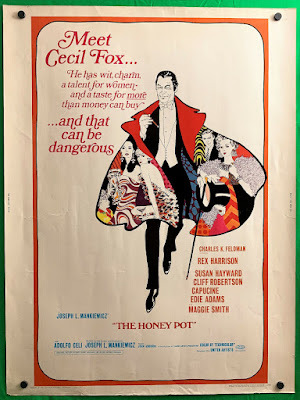Joe Mankiewicz Sticks His Finger in “The Honey Pot”

The Mankiewicz brothers weregenuine Hollywood legends. Elder brotherHerman co-wrote Orson Welles’ Citizen Kane, and literally hundreds ofother classic films, starting in 1926 and ending not long before his earlydeath in 1953. But Herman was something of an underachiever compared to youngerbrother Joseph. Joe (1909-1993) is credited with writing almost 40 films, anddirecting 22. In 1950-1951 he achieved the remarkable feat of winning fourOscars, two for directing and writing the adapted screenplay of A Letter toThree Wives, and two more for writing and directing All About Eve. Henabbed his last Oscar nomination in 1973 for directing his last film, Sleuth.(The expert in all this is my colleague Sydney Ladensohn Stern, for her fascinating2019 study, The Brothers Mankiewicz: Hope, Heartbreak, and HollywoodClassics.)
It was near the end of JoeMankiewicz's fabulous career—which also included everything from the notorious Cleopatrato a documentary on Martin Luther King—that he wrote and directed 1967’s TheHoney Pot. This dark-hued farce, set in a Venice palazzo, has some of thequalities demonstrated by Rian Johnsonin 2019’s Knives Out. In both there’s a lavishly decorated set, acluster of mismatched people, and more than a whiff of murder most foul. KnivesOut boasts, along with a lot of clever business, a subtle and highlyamusing Stephen Sondheim joke. The Honey Pot is even more esoteric,basing its plot on Ben Jonson’s black comedy from 1605, Volpone. As atrue English major, Mankiewicz clearly enjoyed esoteric references to hissource material. His leading character’s surname, Fox, is a clear nod to the“sly fox” of Volpone’s English translation. And Fox’s henchman (Mosca inthe original) is now William McFly. (Get it?)
The crafty Fox is played toperfection by frequent Mankiewicz star Rex Harrison. I’ve heard obnoxiousstories about the real-life Harrison, but in this film he’s delightfullydevious. (Serious hilarity comes from the fact that, as a man obsessed withballet, he madly pirouettes around his home to endless repetitions ofPonchielli’s “Dance of the Hours.” Yes, that’s the piece to which the hipposcavort in Disney’s Fantasia.) Other major players include Cliff Robertson as the sidekick Fox recruitsfor his nefarious schemes, as well as the salty Susan Hayward, the elegant Capucine, and the brassy EdieAdams, all of them playing former loves who are tricked into appearing at Fox’sfake deathbed in hopes of inheriting his fortune. I need a separate mention forMaggie Smith, who also takes part in the macabre festivities, in the role ofHayward’s rather prim and veddy British nurse and companion. In 1967, Smith wasnot brand-new to films. But she was hardly the legendary dowager she has sincebecome in such productions as Gosford Park and TV’s Downton Abbey. Inher early 30s, she was a pretty and rather vulnerable-looking redhead, one whohad just received an Oscar nomination for playing Desdemona opposite ablackfaced (but highly impressive) Laurence Olivier in a filmed version of Othello.Her role in The Honey Pot seems modest at first, but proves to havehidden depths that take us by surprise. Her scenes of give-and-take withHarrison, in which she plays the innocent and he offers a nicely ironicdisquisition on the passage of time, are at the heart of this film.
But all is not perfection. Along with the movie’s wit and such inspired moments as the crafty local police detective watching TV’s Perry Mason dubbed into Italian, there are key plot strands that simply make no sense. Maybe that’s part of the joke too.
Beverly in Movieland
- Beverly Gray's profile
- 10 followers



